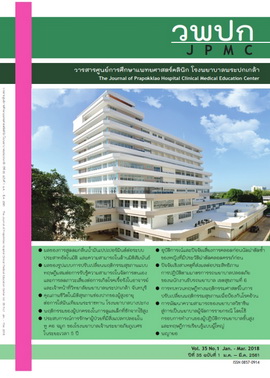Causal Relationships of Factors Effected to the efficiency in complying with the Ambulance Safety Measures of ambulance drivers, Health Region 6
Main Article Content
Abstract
Background: During the year 2015-2017 a study shows that there were 129 events of ambulances accident, 261 people were injured and 25 died, so in 2015, the Ambulance Safety Measure has been set up in all health regions by Ministry of Public Health. However, the measures focused only on drive safely but there was stills lack of essential factors to support the success of the measures.
Objectives: 1) To study the level of health literacy, quality of work life and the efficiency of complying with the Ambulance Safety Measure. 2) To study the causal relationships of factors effected to the efficiency in complying with the Ambulance Safety Measures on ambulance drivers.
Materials and methods: This consisted of cross-sectional descriptive study 219 samples. Stratified random sampling and simple random sampling were used. The instrument was a questionnaire. Structural Equation Modeling (SEM) was used to analyze the data.
Results: The study found that: 1) Ambulance drivers had high level in health literacy, quality of work life and the efficiency of complying with the Ambulance Safety Measures. 2) Quality of work life had direct and indirect effects on the efficiency of complying with the Ambulance Safety Measures, but health literacy had only direct effect and larger effect than quality of work life. However, both factors were able to predict the efficiency of complying with the Ambulance Safety Measures in high score (70 %).
Conclusion: The main factor which effected to the efficiency of complying with the Ambulance Safety Measures was health literacy; however quality of work life was still important to go on with it.
Article Details
References
2. National Institute for Emergency Medicine. Ambulance accident report. Samut Sakhorn: Born to Be Publishing; 2015.
3. National Institute for Emergency Medicine. Prevention: safety guide lines for ambulance. Nonthaburi: Ultimate Printing; 2014.
4. Ginggeaw S, Prasertsri N. The relationship between health literacy and health behaviors among older adults who have multi-morbidity. Nursing Journal of the Ministry of Public Health 2015; 25(3): 43-54.
5. Sakpaisan A. Quality of work life affecting work efficiency of staff of Inter Realty Management Co.Ltd. (IRM) [dissertation]. Pathum Thani: Rajamangala University of Technology Thanyaburi; 2013.
6. Hongkrajok H. Influences of health literacy, perceived self-efficacy and patient-health care provider communication on self-care behaviors among patients with primary hypertension [dissertation}. Chonburi: Burapha University, 2009.
7. Naiyapatana O. Quantitative and qualitative research methodologies in behavioral and social sciences. Bangkok: Samlada Printing; 2005.
8. Tipwong A, Noompoon J. The associations between health literacy related to obesity and health behavior: Eating and Exercise in over nutritional Children, Bongkok. Journal of Public Health Nursing 2014; 28 (2): 1-11.
9. Peerayut Y. Quality of work life affecting work efficiency among operating staff of RS Co.Ltd [dissertation]. Bangkok: University of the Thai Chamber of Commerce; 2008.
10. Suesatdee K. Quality of working life and performance effectiveness of stenographer official of Secretariat of The House of Representatives [dissertation]. Bangkok: Krirk University; 2014.
11. Hair JF, Black B, Babin B, Anderson RE, Tatham RL. Multivariate data analysis. 6th ed. New Jersey: Pearson Prentice Hall, 2006.
12. Bollen KA. Structure equations with latent variables. New York: John Wiley & Sons, 1989.
13. Pirom W. Causal factors affecting the school effectiveness in the upper northern highland region of Thailand [dissertation]. Chonburi; Burapa University, 2016.
14. Chotivanich P. Quality of work life and organizational commitment that affect happiness at work of University Lecturer. Executive Journal 2017; 37 (1): 83-96.
15. Kuhapanya S. Working life quality affecting employees’ performance satisfaction and working behavioral trend of an international company [dissertation]. Bangkok: Srinakharinwirot University, 2009.
16. Petchtang S, Kaewpan W, Kalampakorn S, Sillabutra J. Factors related to quality of work life of nurses working in Primary Health Care Units in the Central Region of Thailand. Journal of Public Health Nursing 2004; 28(1): 29-42.
17. Siegrist J, Wege N, Puhlhofer F, Wahrender M. A short generic measure of work stress in the era of globalization: effect-reward imbalance. Int Arch Occup Environ Health 2009; 2:1005-13.
18. Kaewtong N, Termsirikulchai L, Leelaphun P, Kengganpanich T, Kaeodumkoeng K. Health Literacy of group at risk of hypertension at Ban Nonghoi Sub-district Health Promoting Hospital, Sakaeo province. Journal of Boromarajonani College of Nursing, Bangkok 2014; 30 (1): 45-56.
19. Indhraratana A. Health literacy of health professionals. Journal of the Royal Thai Army Nurses 2014;15(3): 174-8.
20. Ratchapholb B. Employees’ quality of work life relating to affective Well-being and performance behavioral trend of a private organization [dissertation]. Bangkok: Srinakharinwirot University; 2008.
21. Chaiprasert N. The quality of work life affecting work efficiency in industrial factories in Pathumthani Province. SSRU Graduate Studies Journal 2015; 8(2): 51-64.

